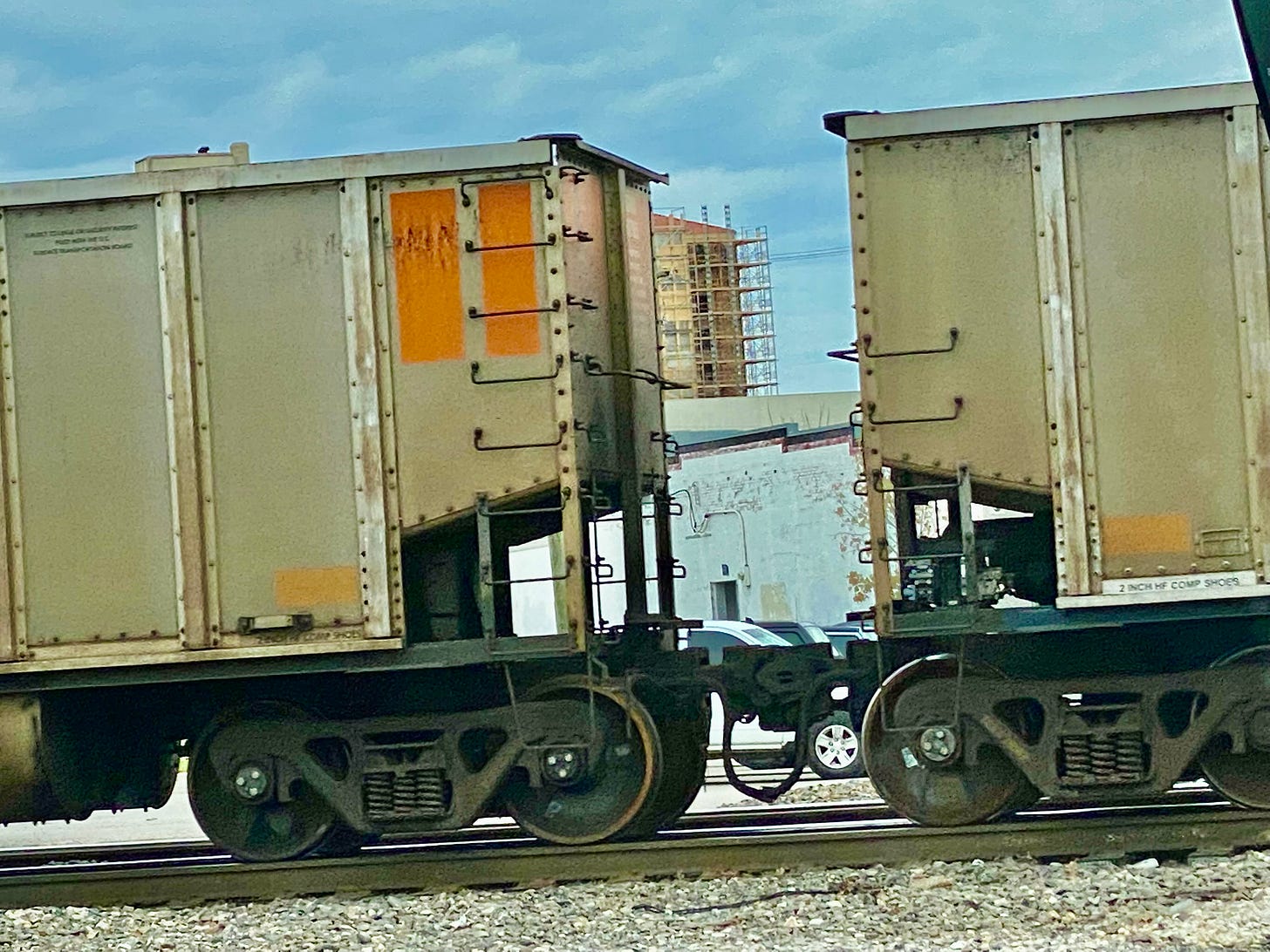Union Pacific and BNSF trains pass through Temple multiple times a day, carrying millions of gallons of gallons of crude oil and toxic chemicals. David Stone photo
DAVID STONE | OUR TOWN TEMPLE
An incident similar to the toxic train wreck that spewed deadly chemicals in East Palestine, Ohio, could happen here, but local emergency management officials say they are more concerned about interstate-related disasters than train derailments.
“Many chemicals pass through Temple and Bell County,” said Fire & Rescue Chief Mitch Randles. “But because Temple is such a large railyard town, the trains that come through are usually going quite slow. I’m much more concerned about what goes up and down I-35.”
“All kinds of chemicals pass through Temple on the interstate and on the train tracks, but there are a lot more instances of spills on I-35,” he said.
According to Union Pacific spokesperson Robynn Tysver, railroad companies are required by law to transport chemicals and other hazardous commodities that Americans use daily, including fertilizers, ethanol, crude oil and chlorine.
“Union Pacific shares the same goals as our customers and the communities we serve, and that’s to deliver every tank car safely,” Tysver said. “We have a 24-hour, 365-days-a-year emergency critical center and a robust emergency management plan in place that is activated in the event of an emergency.”
“We also have Hazardous Materials Management teams placed regionally throughout our network to prevent, prepare and respond to emergency events in Central Texas and throughout the US,” she said.
Temple Fire & Rescue has one of two hazmat teams that serve a seven-county Central Texas area that includes Bell, Milam, Coryell, San Saba, Hamilton, Mills and Lampasas counties. The other team is based in Killeen.
“I’ve been here going on nine years, and we’ve responded to about five train derailments during that time,” Randles said. “Most have been cases of a railcar jumping the tracks, but we did respond to a major train wreck near Cameron during Snowvid (February 2021).”
Randles and Temple Emergency Management program manager Jennifer Henager said hazmat and emergency preparedness is a big part of training for disasters, both natural or man-made.
“(Temple Fire & Rescue) has 122 people who would be able to participate in a hazardous materials disaster,” Randles said. “About 35 of those have very specialized training. We train with BNSF rail rescue crews on a regular basis.”
Henager said Temple’s Emergency Management Office “is responsible for the planning, coordination and preparedness of available resources for the alleviation of, response to and recovery from all hazards involving storms, disasters and catastrophes.
“We have a great working relationship with our emergency partners, including both Union Pacific and BNSF,” she said. “Our hazmat team has regular communication with them and that includes some side-by-side training. Should anything happen here, we would work very closely with railroad safety and response teams to ensure the spill is handled appropriately.”
“Additionally, we encourage businesses near a railroad crossing to have shelter-in-place and evacuation plans for their facility should a spill occur near them,” Henager said. “We can provide technical assistance as needed.”
Although Amtrak doesn’t transport chemicals and doesn’t pose the same concerns as freight trains, Henager said Temple emergency units would work with their safety and response teams if a passenger train were to derail here.
Randles said the protection of life would be the top priority if a chemical spill occurred in Temple — either on the railroad tracks or on a highway.
“We would need to determine what was leaking and if we need to evacuate,” he said. “Then we would focus on stopping or containing the leak. Each incident like this is a different animal — they are all different.”
“We deal with small leaks on a monthly basis,” he said. “Most of what we see are fuel spills. In a large spill where people are affected, we would bring in physicians and medical help. If needed, we would decontaminate the people at the scene, then transport them to a local hospital.”
“Once the railroad rescue and recovery teams arrived, we would assist them,” he said. “We have clean-up contractors based in Waco and Austin, and the railroads have clean-up teams as well.”
Randles said railroads are regulated and highly organized, and it is fairly easy to pinpoint what the trains are carrying. The trucking industry is less regulated and determining what chemicals are being spilled from a tractor-trailer is far more difficult.
“The train engineer has a manifest that provides information about what chemicals are in each tanker car,” Randles said. “If for some reason we can’t get to the manifest, there’s also a website we have access to that provides the same information.”
“We have myriad chemicals passing through Temple all the time, and sometimes these trains carry very large quantities. The other day I counted 150 tanker cars on a single train. But like I said, most of the trains passing through Temple are low speed — an accident most likely would be minor.”
Henager said a grant has been applied for that would fund a commodities study to determine exactly what chemicals are coming through Bell County and in what quantity.
“The study would let us know additional training we need to provide for our crews,” she said. “It would let us know if we have the right equipment and procedures in place.”
Randles said Temple Fire & Rescue already has equipment for monitoring waterways and air quality in the event of contamination.
“We have the equipment, and we have personnel who know how to use it,” he said. “We train on a regular basis.”
Tysver, the UP spokesperson, said railroads are the safest mode of transportation.
“More than 99.9 percent of the hazardous commodities carried by rail reach their destination safely and without release,” she said. “Union Pacific is using new technology and education to reduce risks of derailment, and we are enhancing our training programs and re-emphasizing our safety culture through a joint effort with our partners.”
“Railroads frequently inspect wheels, rail cars and tracks to keep operations running safely and smoothly,” Tysver said. “Technology is making this process even safer and more precise, while playing an important role in preventing derailments.”
Rail companies such as BNSF and Union Pacific use a variety of new technologies and sensors to create a safer railroad environment and to reduce the number of derailments by inspecting tracks and trains.
The Ultrasonic Wheel Defect Detector, for instance, uses ultrasound technology to inspect wheels on a moving train.
“Each year, this system checks more than 80,000 wheel sets in the Union Pacific system,” Tysver said. “It helps uncover wheel defects that otherwise would have gone undetected.”
Another device aids railroad companies in track inspections and searches for damaged rails or lumber.
“The Autonomous Track Geometry Measurement Systems, we just call it the ATGMS, is housed in a regular boxcar and is powered by a solar panel,” she said. “The system consists of a GPS unit, a camera and laser system positioned underneath the body, and an inertial measuring pack that senses movement left, right, up and down to assess track health.”
Tysver said thousands of wheel sensors are placed along UP’s 32,000-mile rail network.
“These sensors are part of a sophisticated system that identifies wheel defects like flat spots and worn bearings,” she said. “In doing so, the system allows the railroad to troubleshoot defects that are either indiscernible or imperceptible by other means. They help us identify critical defects and prevent derailments.”
Henager said the railroads, city departments, hospitals and neighboring cities and counties are working together and have plans in place for disasters in Temple and the surrounding region.
“We are working on updates to our training and exercise schedules to ensure we are as prepared as possible when the time comes,” she said. “We have an excellent team that is ready to respond to any crisis that hits the city of Temple and neighboring communities.”
What’s up, Central Texas?
I hope you have enjoyed my offerings this week. Get ready — I have a lot of irons in the fire. Topics such as homelessness (more to come), lake fun and the state of faith in Bell County. Stay tuned! I want to express my appreciation to the many readers who have used the “tip jar” button to help support community journalism. Thank you. If you value my journalism, please show your support:











